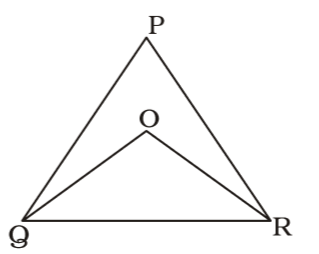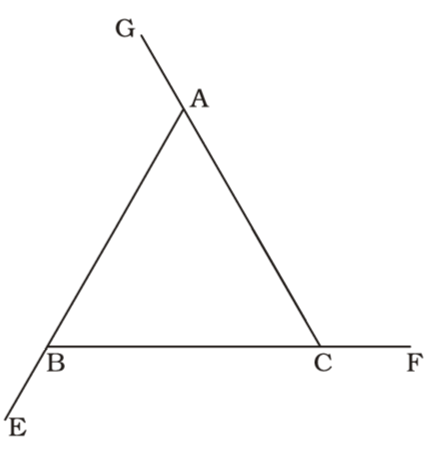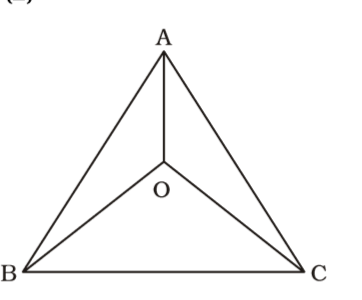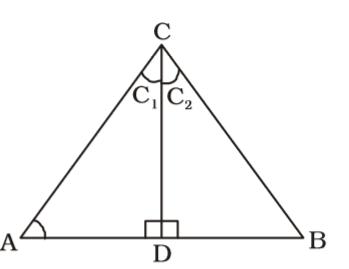Plane Geometry
- Internal bisectors of ∠Q and ∠R of ∆PQR intersect at O. If ∠ROQ = 96° then the vlaue of ∠RPQ is
-
View Hint View Answer Discuss in Forum
As per the given in question , we draw a figure of triangle ABC

∠ROQ = 96°
In ∆ OQR
∠OQR + ∠ORQ + ∠QOR = 180°⇒ 1 ∠PQR + 1 ∠PRQ + 96° = 180° 2 2 ⇒ 1 (∠PQR + ∠PRQ) = 180° – 96° = 84° 2
Correct Option: C
As per the given in question , we draw a figure of triangle ABC

∠ROQ = 96°
In ∆ OQR
∠OQR + ∠ORQ + ∠QOR = 180°⇒ 1 ∠PQR + 1 ∠PRQ + 96° = 180° 2 2 ⇒ 1 (∠PQR + ∠PRQ) = 180° – 96° = 84° 2
⇒ ∠PQR + ∠PRQ = 2 × 84° = 168°
In ∆ PQR,
∴ ∠QPR = 180° – ( ∠PQR + ∠PRQ ) = 180° – 168° = 12°
- The measures of two angles of a triangle are in the ratio 4 : 5. If the sum of these two measures is equal to the measure of the third angle, find the smallest angle.
-
View Hint View Answer Discuss in Forum
Let Two angles of triangle = 4k and 5k
According to the question,
2(4k + 5k) = 180°
⇒ 18k = 180°⇒ k = 180° = 10° 18
Correct Option: D
Let Two angles of triangle = 4k and 5k
According to the question,
2(4k + 5k) = 180°
⇒ 18k = 180°⇒ k = 180° = 10° 18
∴ The smallest angle = 4k = 4 × 10 = 40°
- ABC is a triangle and the sides AB, BC and CA are produced to E, F and G respectively. If ∠CBE = ∠ACF = 130° then the value of ∠GAB is
-
View Hint View Answer Discuss in Forum
On the basis of given in question , we draw a figure triangle ABC ,

∠CBE = 130°
∴ ∠ABC = 180° – 130° = 50°
∠ACF = 130°
∴ ∠ACB = 180° – 130° = 50°Correct Option: A
On the basis of given in question , we draw a figure triangle ABC ,

∠CBE = 130°
∴ ∠ABC = 180° – 130° = 50°
∠ACF = 130°
∴ ∠ACB = 180° – 130° = 50°
∴ ∠BAC = 180° – 50° – 50° = 80°
∴ ∠GAB = 180° – 80° = 100°
- If O is the in-centre of ∆ABC; if ∠BOC = 120°, then the measure of ∠BAC is
-
View Hint View Answer Discuss in Forum
On the basis of given in question , we draw a figure triangle ABC ,

BO, CO and AO are internal bisectors of ∠B, ∠C and ∠A respectively.
Here , ∠BOC = 120°∴ ∠BOC = 90° + ∠A 2 ⇒ 120° = 90° + ∠A 2
Correct Option: B
On the basis of given in question , we draw a figure triangle ABC ,

BO, CO and AO are internal bisectors of ∠B, ∠C and ∠A respectively.
Here , ∠BOC = 120°∴ ∠BOC = 90° + ∠A 2 ⇒ 120° = 90° + ∠A 2 ⇒ ∠A = 120° - 90° = 30° 2
∴ ∠A = 30 × 2 = 60°
- In ∆ABC, ∠A < ∠B. The altitude to the base divides vertex angle C into two parts C1 and C2,with C2,adjacent to BC. Then
-
View Hint View Answer Discuss in Forum
Firstly , We draw a figure of triangle ABC

∠BAC < ∠CBA
∠CDA = ∠CDB = 90°; ∠C1 > ∠C2
∠A + ∠C1 = 90°
∠B + ∠C2 = 90°
∴ ∠A + ∠C1 = ∠B + ∠C2Correct Option: C
Firstly , We draw a figure of triangle ABC

∠BAC < ∠CBA
∠CDA = ∠CDB = 90°; ∠C1 > ∠C2
∠A + ∠C1 = 90°
∠B + ∠C2 = 90°
∴ ∠A + ∠C1 = ∠B + ∠C2
∴ ∠B – ∠A = ∠C1 – ∠C2

